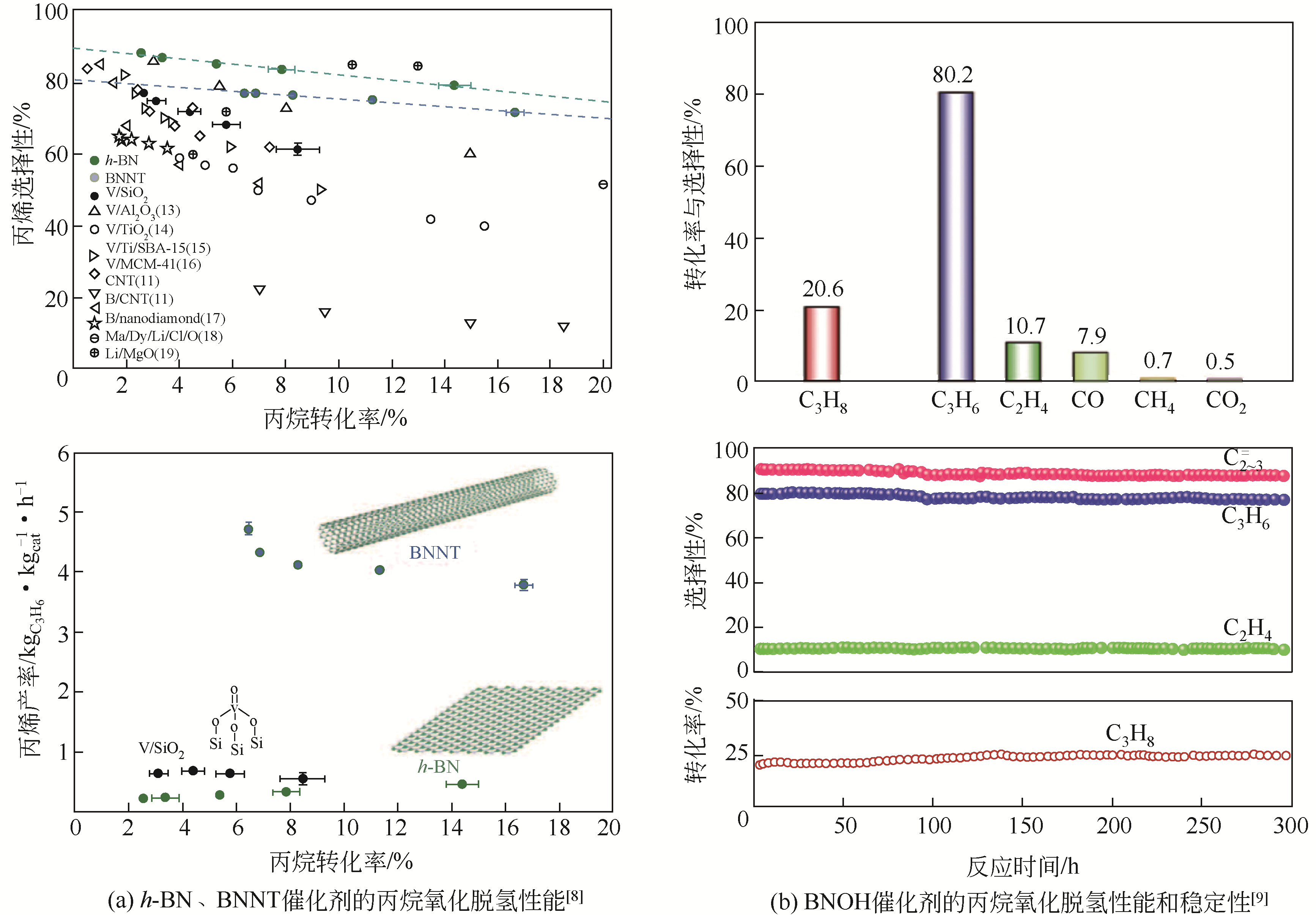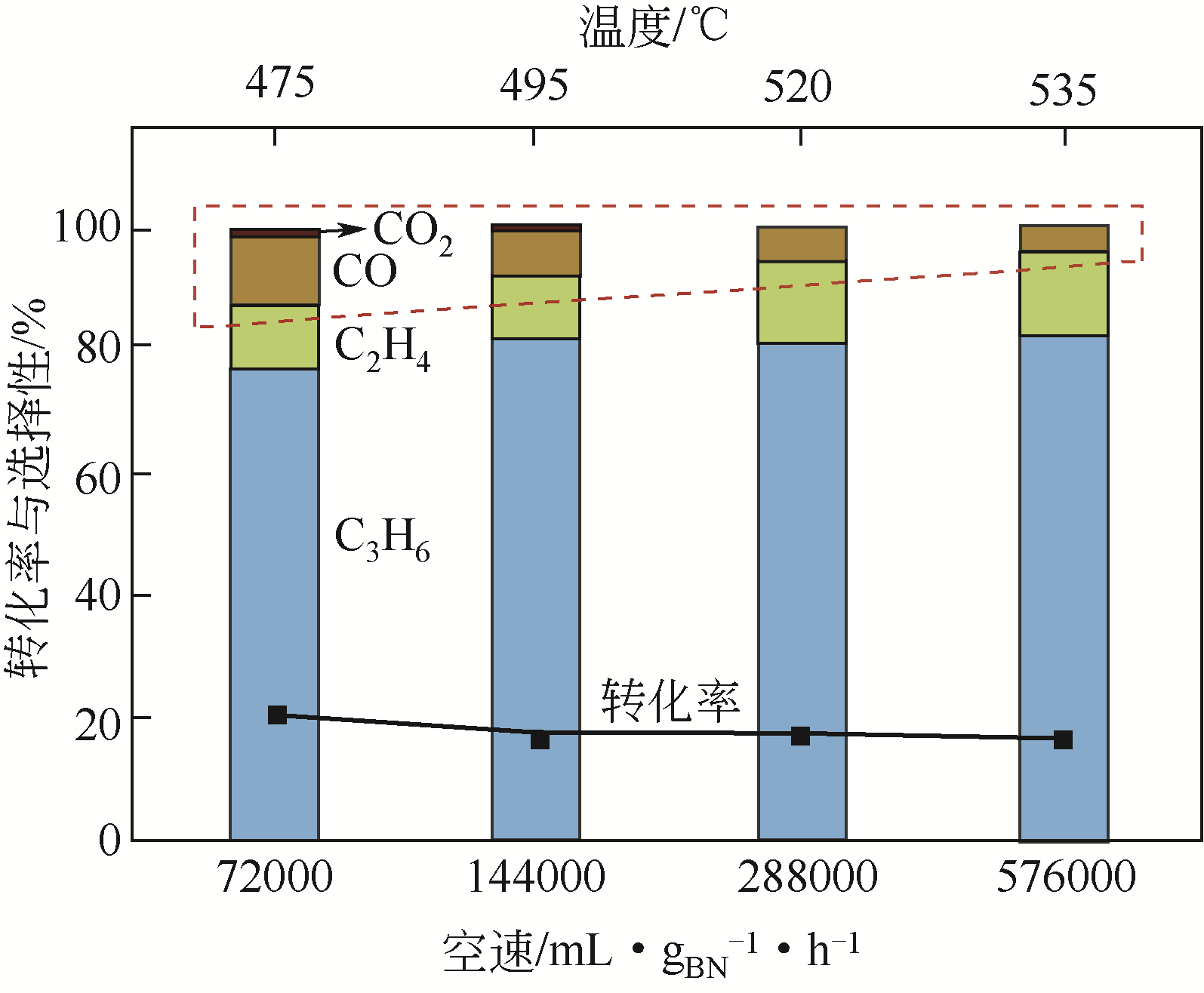| 1 |
CAVANI F, BALLARINI N, CERICOLA A. Oxidative dehydrogenation of ethane and propane: how far from commercial implementation?[J]. Catal. Today, 2007, 127(1/2/3/4): 113-131.
|
| 2 |
SATTLER J J, RUIZ-MARTINEZ J, SANTILLAN-JIMENEZ E, et al. Catalytic dehydrogenation of light alkanes on metals and metal oxides[J]. Chem. Rev., 2014, 114(20): 10613-10653.
|
| 3 |
闫冰, 盛健, 邱彬, 等. 低碳烷烃氧化脱氢制烯烃非金属催化体系研究进展[J]. 中国科学: 化学, 2020, 50(7): 832-846.
|
|
YAN B, SHENG J, QIU B, et al. Progress in the oxidative dehydrogenation of light alkanes to light olefins on metal-free catalysts[J]. Sci. Sin. Chim., 2020, 50(7): 832-846.
|
| 4 |
GARTNER C A, VEEN A C VAN, LERCHER J A. Oxidative dehydrogenation of ethane: common principles and mechanistic aspects[J]. ChemCatChem, 2013, 5(11): 3196-3217.
|
| 5 |
SHI L, WANG Y, YAN B, et al. Progress in selective oxidative dehydrogenation of light alkanes to olefins promoted by boron nitride catalysts[J]. Chem. Commun., 2018, 54(78): 10936-10946.
|
| 6 |
SHI L, DENG G M, LI W C, et al. Al2O3 nanosheets rich in pentacoordinate Al3+ ions stabilize Pt-Sn clusters for propane dehydrogenation[J]. Angew. Chem., Int. Ed., 2015, 54(47): 13994-13998.
|
| 7 |
GAO X Q, LU W D, HU S Z, et al. Rod-shaped porous alumina-supported Cr2O3 catalyst with low acidity for propane dehydrogenation[J]. Chin. J. Catal., 2019, 40(2): 184-191.
|
| 8 |
GRANT J T, CARRERO C A, GOELTL F, et al. Selective oxidative dehydrogenation of propane to propene using boron nitride catalysts[J]. Science, 2016, 354(6319): 1570-1573.
|
| 9 |
SHI L, WANG D, SONG W, et al. Edge-hydroxylated boron nitride for oxidative dehydrogenation of propane to propylene[J]. ChemCatChem, 2017, 9(10): 1788-1793.
|
| 10 |
WENG Q, WANG X, WANG X, et al. Functionalized hexagonal boron nitride nanomaterials: emerging properties and applications[J]. Chem. Soc. Rev., 2016, 45(14): 3989-4012.
|
| 11 |
HANSEN T W, WAGNER J B, HANSEN P L, et al. Atomic-resolution in situ transmission electron microscopy of a promoter of a heterogeneous catalyst[J]. Science, 2001, 294(5546): 1508-1510.
|
| 12 |
WANG Y, SHI L, LU W, et al. Spherical boron nitride supported gold-copper catalysts for the low-temperature selective oxidation of ethanol[J]. ChemCatChem, 2017, 9(8): 1363-1367.
|
| 13 |
SHI L, YAN B, SHAO D, et al. Selective oxidative dehydrogenation of ethane to ethylene over a hydroxylated boron nitride catalyst[J]. Chin. J. Catal., 2017, 38(2): 389-395.
|
| 14 |
VENEGAS J M, GRANT J T, MCDERMOTT W P, et al. Selective oxidation of n-butane and isobutane catalyzed by boron nitride[J]. ChemCatChem, 2017, 9(12): 2118-2127.
|
| 15 |
YAN B, LI W C, LU A H. Metal-free silicon boride catalyst for oxidative dehydrogenation of light alkanes to olefins with high selectivity and stability[J]. J. Catal., 2019, 369: 296-301.
|
| 16 |
GRANT J T, MCDERMOTT W P, VENEGAS J M, et al. Boron and boron-containing catalysts for the oxidative dehydrogenation of propane[J]. ChemCatChem, 2017, 9(19): 3623-3626.
|
| 17 |
SHI L, WANG D, LU A H. A viewpoint on catalytic origin of boron nitride in oxidative dehydrogenation of light alkanes[J]. Chin. J. Catal., 2018, 39(5): 908-913.
|
| 18 |
HUANG R, ZHANG B, WANG J, et al. Direct insight into ethane oxidative dehydrogenation over boron nitrides[J]. ChemCatChem, 2017, 9(17): 3293-3297.
|
| 19 |
LI H, ZHANG J, WU P, et al. O2 activation and oxidative dehydrogenation of propane on hexagonal boron nitride: mechanism revisited[J]. J. Phys. Chem. C, 2019, 123(4): 2256-2266.
|
| 20 |
ZHOU Y, LIN J, LI L, et al. Enhanced performance of boron nitride catalysts with induction period for the oxidative dehydrogenation of ethane to ethylene[J]. J. Catal., 2018, 365: 14-23.
|
| 21 |
LOVE A M, THOMAS B, SPECHT S E, et al. Probing the transformation of boron nitride catalysts under oxidative dehydrogenation conditions[J]. J. Am. Chem. Soc., 2019, 141(1): 182-190.
|
| 22 |
LU W D, WANG D, ZHAO Z, et al. Supported boron oxide catalysts for selective and low-temperature oxidative dehydrogenation of propane[J]. ACS Catal., 2019, 9(9): 8263-8270.
|
| 23 |
LIU Q, WU Y, XING F, et al. B2O3@BPO4 sandwich-like hollow spheres as metal-free supported liquid-phase catalysts[J]. J. Catal., 2020, 381: 599-607.
|
| 24 |
MCDERMOTT W P, VENEGAS J, HERMANS I. Selective oxidative cracking of n-butane to light olefins over hexagonal boron nitride with limited formation of COx[J]. ChemSusChem, 2020, 13(1): 152-158.
|
| 25 |
WANG Y, ZHAO L, SHI L, et al. Methane activation over a boron nitride catalyst driven by in situ formed molecular water[J]. Catal. Sci. Technol., 2018, 8(8): 2051-2055.
|
| 26 |
TIAN J, TAN J, XU M, et al. Propane oxidative dehydrogenation over highly selective hexagonal boron nitride catalysts: the role of oxidative coupling of methyl[J]. Sci. Adv., 2019, 5(3): eaav8063.
|
| 27 |
VENEGAS J M, HERMANS I. The influence of reactor parameters on the boron nitride-catalyzed oxidative dehydrogenation of propane[J]. Org. Process Res. Dev., 2018, 22(12): 1644-1652.
|
| 28 |
ZHANG X, YOU R, WEI Z, et al. Radical chemistry and reaction mechanisms of propane oxidative dehydrogenation over hexagonal boron nitride catalysts[J]. Angew. Chem., Int. Ed., 2020, 59(21): 8042-8046.
|
| 29 |
HONDA Y, TAKAGAKI A, KIKUCHI R, et al. Oxidative dehydrogenation of ethane using ball-milled hexagonal boron nitride[J]. Chem. Lett., 2018, 47(9): 1090-1093.
|
| 30 |
CHATURBEDY P, AHAMED M, ESWARAMOORTHY M. Oxidative dehydrogenation of propane over a high surface area boron nitride catalyst: exceptional selectivity for olefins at high conversion[J]. ACS Omega, 2018, 3(1): 369-374.
|
| 31 |
CAO L, DAI P, TANG J, et al. Spherical superstructure of boron nitride nanosheets derived from boron-containing metal-organic frameworks[J]. J. Am. Chem. Soc., 2020, 142(19): 8755-8762.
|
| 32 |
QIU B, JIANG F, LU W D, et al. Oxidative dehydrogenation of propane using layered borosilicate zeolite as the active and selective catalyst[J]. J. Catal., 2020, 385: 176-182.
|
| 33 |
LU W D, GAO X Q, WANG Q G, et al. Ordered macroporous boron phosphate crystals as metal-free catalysts for the oxidative dehydrogenation of propane[J]. Chin. J. Catal., 2020, 41(12): 1837-1845.
|
| 34 |
WANG Y, LI W C, ZHOU Y X, et al. Boron nitride wash-coated cordierite monolithic catalyst showing high selectivity and productivity for oxidative dehydrogenation of propane[J]. Catal. Today, 2020, 339: 62-66.
|
| 35 |
ZHOU Y X, WANG Y, LU W D, et al. A high propylene productivity over B2O3/SiO2@honeycomb cordierite catalyst for oxidative dehydrogenation of propane[J]. Chin. J. Chem. Eng., 2020, 28(11): 2778-2784.
|
| 36 |
TIAN J S, LIN J H, XU M L, et al. Hexagonal boron nitride catalyst in a fixed-bed reactor for exothermic propane oxidation dehydrogenation[J]. Chem. Eng. Sci., 2018, 186: 142-151.
|
| 37 |
GUO F, YANG P, PAN Z, et al. Carbon-doped BN nanosheets for the oxidative dehydrogenation of ethylbenzene[J]. Angew. Chem., Int. Ed., 2017, 56(28): 8231-8235.
|
| 38 |
SHENG J, YAN B, HE B, et al. Nonmetallic boron nitride embedded graphitic carbon catalyst for oxidative dehydrogenation of ethylbenzene[J]. Catal. Sci. Technol., 2020, 10(6): 1809-1815.
|
| 39 |
NASH D J, RESTREPO D T, PARRA N S, et al. Heterogeneous metal-free hydrogenation over defect-laden hexagonal boron nitride[J]. ACS Omega, 2016, 1(6): 1343-1354.
|
| 40 |
LI P, LI H, PAN X, et al. Catalytically active boron nitride in acetylene hydrochlorination[J]. ACS Catal., 2017, 7(12): 8572-8577.
|
| 41 |
WU Y, WU P, CHAO Y, et al. Gas-exfoliated porous monolayer boron nitride for enhanced aerobic oxidative desulfurization performance[J]. Nanotechnol., 2018, 29(2): 025604.
|
| 42 |
ZHAO L Y, CHEN J Y, LI W C, et al. B2O3: a heterogeneous metal-free Lewis acid catalyst for carbon dioxide fixation into cyclic carbonates[J]. J. CO2 Util., 2019, 29: 172-178.
|
 ), 陆文多, 闫冰, 邱彬, 周禹希, 王东琪, 陆安慧(
), 陆文多, 闫冰, 邱彬, 周禹希, 王东琪, 陆安慧( )
)
 ), LU Wenduo, YAN Bing, QIU Bin, ZHOU Yuxi, WANG Dongqi, LU Anhui(
), LU Wenduo, YAN Bing, QIU Bin, ZHOU Yuxi, WANG Dongqi, LU Anhui( )
)







